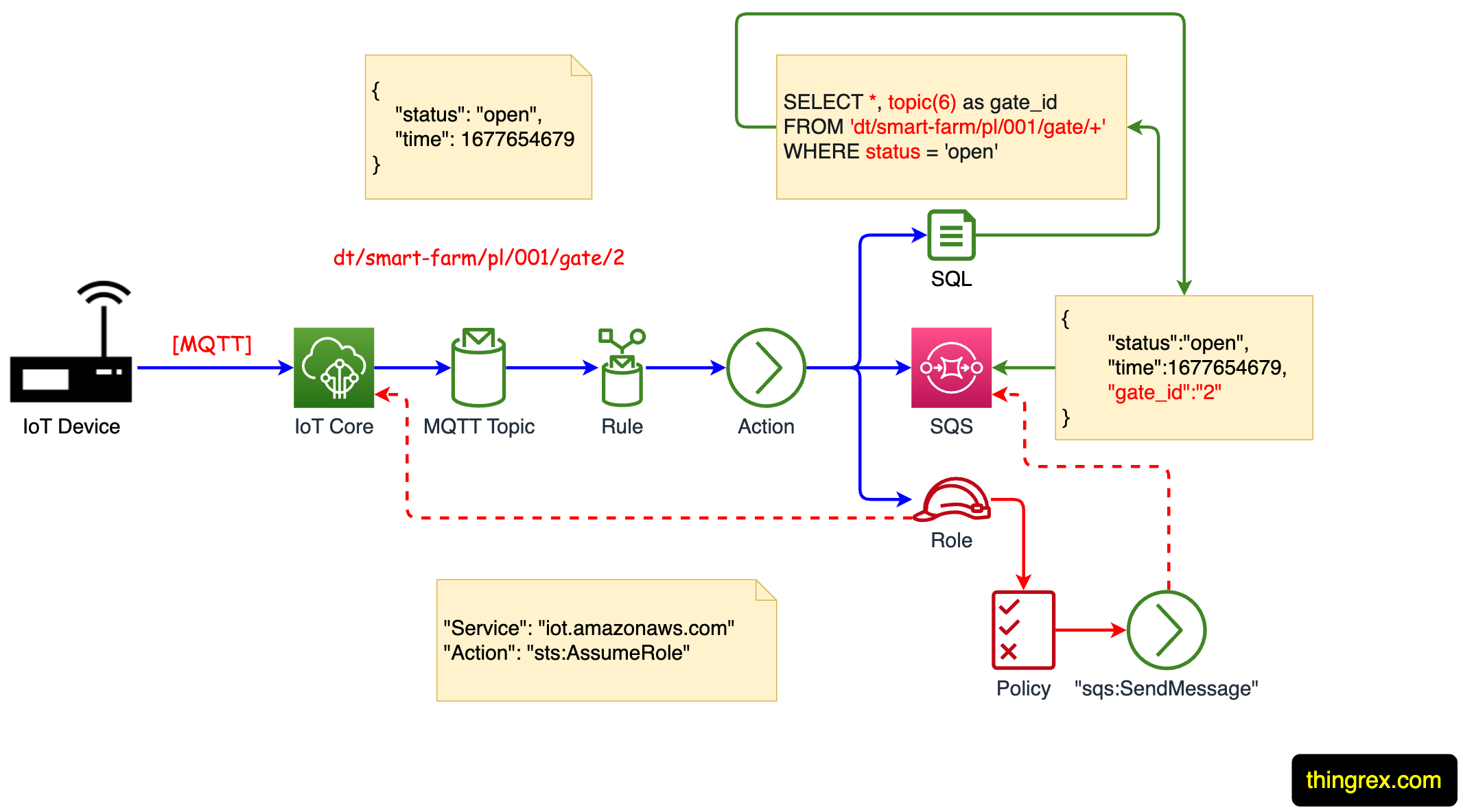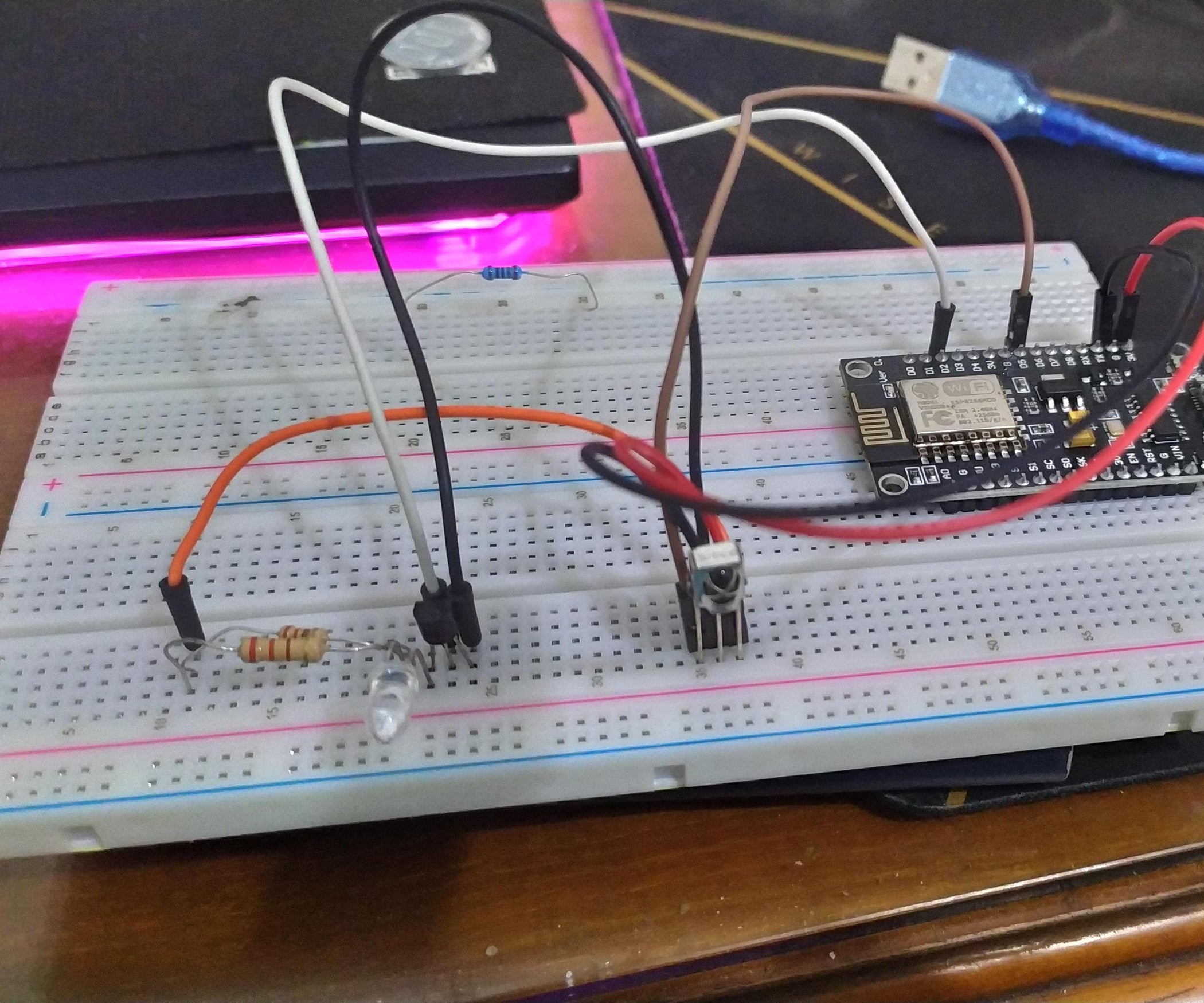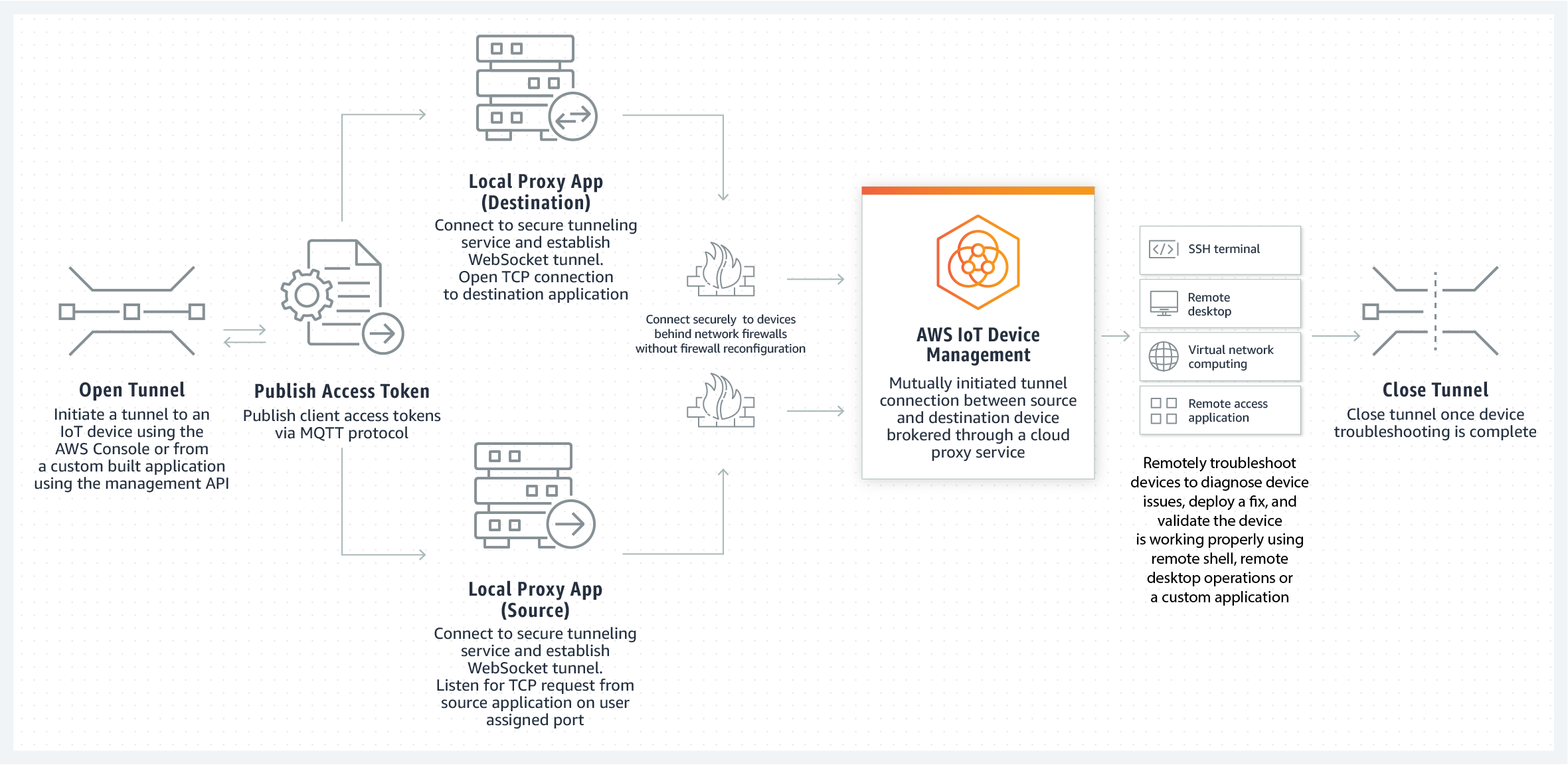Unlock IoT SSH Access On AWS: A Comprehensive Guide!
Are your IoT devices scattered across the globe, feeling as if they're operating in a technological wilderness? The solution isn't just connectivity; it's secure, reliable access. IoT SSH access AWS is not just a feature; it's the bedrock of efficient, secure remote management, offering unparalleled control and peace of mind in a hyper-connected world.
Consider this: your fleet of IoT sensors are deployed in remote wind farms, smart city infrastructure, or even agricultural fields. Without a robust mechanism to securely interact with them, simple tasks such as software updates, configuration tweaks, or critical troubleshooting can turn into logistical nightmares. AWS, with its comprehensive suite of services, steps in as the guardian of your IoT kingdom. It provides the infrastructure and tools necessary to establish and maintain secure SSH connections, ensuring your devices remain both accessible and protected.
| Attribute | Details |
|---|---|
| Name | Amazon Web Services (AWS) |
| Category | Cloud Computing Platform and Services |
| Founded | 2002 |
| Headquarters | Seattle, Washington, USA |
| Key Services | Compute (EC2, Lambda), Storage (S3, Glacier), Database (RDS, DynamoDB), Networking (VPC), IoT (IoT Core), AI/ML (SageMaker) |
| Website | aws.amazon.com |
This isn't merely about connecting to devices; it's about unlocking their full potential. Imagine being able to remotely monitor performance metrics, push out critical firmware updates to patch vulnerabilities, and diagnose issues without ever leaving your office. IoT SSH access on AWS transforms the mundane into the manageable, offering a centralized control panel for your entire IoT ecosystem. Think of it as having a universal remote for the Internet of Things, all powered by the robust and scalable infrastructure of AWS.
What is IoT SSH Access?
At its core, IoT SSH access leverages the Secure Shell (SSH) protocol to create encrypted, secure connections between you and your IoT devices. This secure tunnel ensures that all data transmitted from commands to status updates is protected from eavesdropping and tampering. AWS simplifies the implementation and management of these connections, offering tools and services that handle the complexities of authentication, authorization, and secure communication. In essence, it's about bringing enterprise-grade security and manageability to the often-vulnerable world of IoT devices.
Why SSH Access Matters for IoT Devices
In the intricate dance of the Internet of Things, security takes center stage. IoT devices, often deployed in unattended or remote locations, present a tempting target for malicious actors. Physical access might be challenging, but remote exploitation can be devastating. This is where SSH emerges as a critical safeguard, enabling secure remote management without sacrificing control.
Consider these compelling reasons why SSH access is indispensable for IoT deployments:
- Jill Ireland The Actress Activist Charles Bronsons Wife
- Kat Dennings And Israel Unveiling Her Connection Why It Matters
- Security as a Shield: SSH encrypts the entire communication stream, shielding sensitive data from prying eyes and unauthorized access. This encryption is paramount in protecting confidential information transmitted between the device and the management platform.
- Efficiency Unleashed: Forget the costly and time-consuming process of physically visiting each device for routine maintenance. SSH empowers you to perform essential tasks firmware updates, configuration adjustments, and in-depth troubleshooting remotely, saving both time and resources.
- Scalability Without Compromise: As your IoT network expands, SSH access on AWS provides the foundation for scalable management. It allows you to maintain control and security even as your device count grows exponentially, ensuring consistent and reliable operation.
SSH vs Other Protocols
While various protocols offer remote access capabilities, SSH stands head and shoulders above the rest when it comes to security. Unlike HTTP or FTP, which transmit data in plain text, SSH employs robust encryption to protect data in transit. This difference is critical in the context of IoT, where devices often handle sensitive data or control critical infrastructure. The inherent security of SSH makes it the undisputed champion for managing IoT devices, particularly those dealing with confidential information or critical operations.
Setting Up IoT SSH Access on AWS
Now that the importance of SSH access is clear, let's delve into the practical steps of setting it up on AWS. While the initial configuration might seem intricate, with careful guidance, it becomes a manageable and repeatable process.
Here's a comprehensive step-by-step guide to get you started:
- Forge Your AWS Account: If you haven't already, the first step is to create an AWS account. The AWS Free Tier provides a gateway to explore the platform without incurring immediate costs, allowing you to experiment and familiarize yourself with the various services.
- Craft IAM Roles: Identity and Access Management (IAM) roles are the cornerstones of access control in AWS. Create specific roles tailored to the needs of your IoT devices, granting them the precise permissions required to manage SSH access without over-provisioning privileges.
- Fortify Security Groups: Security groups act as virtual firewalls, controlling inbound and outbound traffic to your devices. Configure them meticulously to allow SSH traffic from authorized sources while rigorously blocking all other unauthorized access attempts.
- Equip Yourself with SSH Clients: Depending on your operating system, you'll need a compatible SSH client. PuTTY is a popular and versatile option for Windows users, while macOS and Linux typically come equipped with a built-in SSH command-line tool.
- Validate Your Connection: Once all components are configured, rigorously test your SSH connection to ensure it's functioning as expected. This crucial step helps identify potential misconfigurations or connectivity issues before you deploy your devices in the field.
Using AWS IoT Core
AWS IoT Core is a fully managed service designed to streamline the connection and management of IoT devices at scale. It seamlessly integrates with SSH, providing a centralized platform for managing your entire IoT fleet. Features such as device shadows, which maintain a virtual representation of each device's state, and message routing, which allows you to direct data to the appropriate services, simplify the complexities of large-scale IoT deployments. AWS IoT Core is the command center for your connected world.
Best Practices for Secure IoT SSH Connections
Setting up IoT SSH access is just the first step; maintaining its security is an ongoing responsibility. Security should be paramount, especially in the vulnerable landscape of IoT. Here are some essential best practices to keep your connections secure and your data protected:
- Embrace Strong Passwords: Weak passwords are akin to leaving the front door unlocked. Enforce the use of strong, unique passwords for all your devices, employing a combination of uppercase and lowercase letters, numbers, and symbols.
- Fortify with Two-Factor Authentication: Two-factor authentication (2FA) adds an extra layer of security by requiring a second form of verification, such as a code from a mobile app, in addition to the password. This significantly reduces the risk of unauthorized access even if a password is compromised.
- Maintain Updated Firmware: Regularly updating your devices' firmware ensures they benefit from the latest security patches and feature enhancements. Outdated firmware is a common vulnerability exploited by attackers.
- Vigilantly Monitor Activity: Leverage AWS CloudWatch to monitor your devices for any unusual or suspicious activity. This proactive approach can help you detect and respond to potential security breaches swiftly and effectively.
SSH Key Management
Managing SSH keys is another critical aspect of securing your IoT infrastructure. SSH keys provide a more secure alternative to passwords, eliminating the risk of password-based attacks. Keys should be stored securely, rotated regularly, and protected from unauthorized access. AWS offers tools for managing SSH keys, making it easier to maintain a robust security posture across your IoT deployment.
Troubleshooting Common Issues
Even with meticulous planning and careful execution, unforeseen issues can arise. Here are some common problems you might encounter when setting up IoT SSH access on AWS, along with practical solutions to help you troubleshoot:
- Connection Refused: If you're unable to connect to your device, the first step is to examine your security group settings. Ensure that SSH traffic is explicitly allowed from your IP address or a defined CIDR block.
- Authentication Failure: Double-check your SSH keys and passwords to ensure they are entered correctly. Verify that your IAM roles have the necessary permissions to access the device and perform SSH operations.
- Sluggish Performance: If your SSH connection is experiencing slow performance, consider optimizing your network settings. A faster internet connection or a more efficient network configuration can significantly improve responsiveness.
Using AWS Support
AWS provides comprehensive support plans designed to help you resolve issues quickly and efficiently. Whether you need assistance with initial configuration, troubleshooting complex problems, or simply understanding best practices, AWS support is readily available. Don't hesitate to leverage this valuable resource when you encounter challenges it can save you significant time and frustration.
Advanced Techniques for IoT SSH Access
Once you've mastered the fundamentals of IoT SSH access on AWS, it's time to explore advanced techniques that can further optimize your setup and unlock new possibilities for your IoT projects.
Consider these advanced strategies to enhance your IoT SSH access:
- Automate SSH Connections: Employ scripting languages like Python or Bash to automate your SSH connections, streamlining repetitive tasks and reducing the potential for human error.
- Implement Load Balancing: If you're managing a large and demanding IoT deployment, consider implementing AWS Elastic Load Balancer to distribute SSH traffic evenly across multiple devices, ensuring high availability and optimal performance.
- Proactive Device Health Monitoring: Integrate AWS CloudWatch to proactively monitor the health of your devices and receive automated alerts when critical metrics deviate from expected ranges. This enables you to identify and address potential issues before they escalate into major problems.
SSH Tunneling
SSH tunneling is a powerful technique that enables you to securely access services running on your IoT devices that might otherwise be inaccessible due to firewall restrictions or network configurations. By creating an encrypted tunnel, you can bypass these limitations and access internal services securely from anywhere.
Future Trends in IoT and SSH
The world of IoT and SSH is constantly evolving, driven by rapid advancements in technology. Staying abreast of these trends is essential for maintaining a competitive edge and ensuring the long-term security and scalability of your IoT deployments. Here are some key trends to watch in the coming years:
- The Quantum Computing Threat: The emergence of quantum computing poses a potential threat to traditional encryption algorithms used in SSH. Researchers are actively developing quantum-resistant algorithms to safeguard SSH connections against future quantum-based attacks.
- Edge Computing Revolution: Edge computing, which brings processing power closer to the devices themselves, is transforming the landscape of IoT. This trend will likely influence how SSH is used in IoT networks, enabling more efficient and secure remote management of edge devices.
- AI-Powered Security: Artificial intelligence (AI) and machine learning (ML) are increasingly being integrated into IoT systems to enhance security and automate threat detection. These technologies can analyze network traffic, identify anomalies, and predict potential security breaches before they occur.
Staying Ahead of the Curve
To thrive in the dynamic world of IoT and SSH, continuous learning and adaptation are essential. Stay informed about industry news, attend relevant conferences and workshops, and actively experiment with emerging technologies. The more you know, the better prepared you'll be to navigate the challenges and capitalize on the opportunities that lie ahead. Embrace a mindset of lifelong learning and continuous improvement to remain at the forefront of this rapidly evolving field.
- Vegasnzcom Your Guide To New Zealands Top Online Casino
- Is Ricky Martin Dating News Love Life Current Status

AWS IoT Rules Engine overview

Mastering Iot Ssh Download Aws A Comprehensive Guide ACCDIS English

AWS IoT Device Management Features AWS